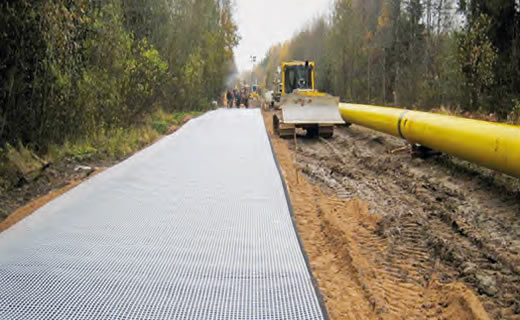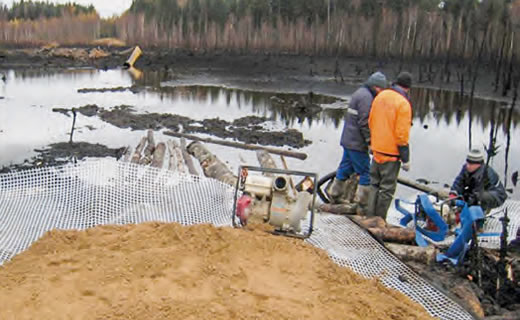
 By NAUE Geosynthetics – In the early hours of an October Saturday, a high-pressure gas pipeline exploded in Lithuania’s Širvintos region near the village of Medžiukai. The Lithuanian Emergency Response Facility arrived at the site to discover that more than 75m of pipe length had been destroyed in the blast. The explosion was powerful enough to have left behind a 15m-diameter, 3m-deep hole that extended along the destroyed section.
By NAUE Geosynthetics – In the early hours of an October Saturday, a high-pressure gas pipeline exploded in Lithuania’s Širvintos region near the village of Medžiukai. The Lithuanian Emergency Response Facility arrived at the site to discover that more than 75m of pipe length had been destroyed in the blast. The explosion was powerful enough to have left behind a 15m-diameter, 3m-deep hole that extended along the destroyed section.
Repair of the pipeline needed to commence immediately, but the site logistics provided significant challenges. The area in which the accident had occurred was surrounded by forest and swamp. Accessing the site with the sort of equipment needed for the safe construction required transportation across and foundations upon soft soils with high groundwater levels, including stretches over peat.
The main contractor, Melinga, was assigned the task of constructing temporary access roads to give heavy equipment and cranes a path to the repair zone. They identified a 1.5km long, 4.7m wide path that could get the necessary equipment to the site and allow work along the entire affected area — so long as proper soil stabilization materials could be found.
GAS PIPELINE ACCESS ROAD CONSTRUCTION
The engineering firm ViaCon Baltic was consulted.
Emergency response nearly always requires “quick and simple” solutions; but when the emergency response involves difficult geotechnical engineering solutions, quick and simple is rarely so easy. In this case, however, a geogrid approach provided a time-sensitive, labor-saving solution.
High-strength Secugrid® geogrids from NAUE were specified to provide the stability for the heavy vehicle traffic and crane footings. The wide rolls met a major goal for emergency response: easy-to-transport, easy-to-install. Geogrids could be delivered to the site quickly and rolled into place without fear of damage or a need to cut and join panels. Secugrid® offered a solution that was not only quick and simple, but highly effective for the site’s soft soils and peat conditions.
Compaction of the site soils would not work well. Dynamic compaction, in fact, was considered dangerous due to the proximity of the old gas pipeline; so, heavy machinery and a steamroller without vibration were the only options.
The design team was not comfortable that enough stability would be created with this approach, so they recommended the installation of wooden logs in the base of the temporary roads along with the installation of a geotextile separation layer.
Combined with the high-strength Secugrid® 40/40 Q1 and Secugrid® 60/60 Q1 geogrids, the road would no longer require dynamic compaction, yet it would still have more than enough strength and protection against subsidence to allow for the heavy equipment passage and work.
Fast, clean access resulted. The special equipment needed for the pipeline reconstruction was brought in and the gas pipeline was back in service safely soon after.
Learn more about NAUE’s geosynthetics, geogrid stabilization of soils, oil and gas sector engineering, and more at www.naue.com.











